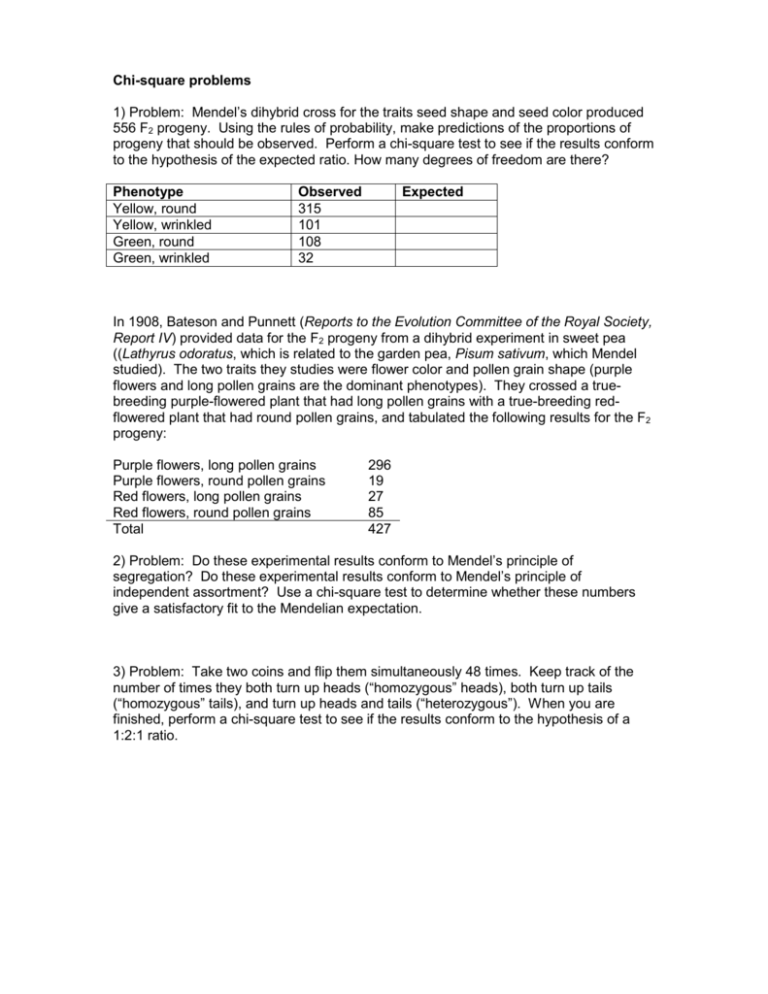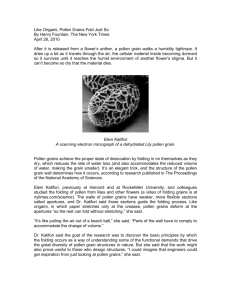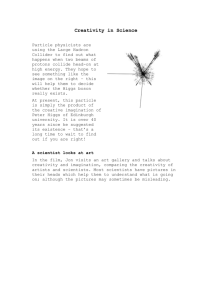Problem:
advertisement

Chi-square problems 1) Problem: Mendel’s dihybrid cross for the traits seed shape and seed color produced 556 F2 progeny. Using the rules of probability, make predictions of the proportions of progeny that should be observed. Perform a chi-square test to see if the results conform to the hypothesis of the expected ratio. How many degrees of freedom are there? Phenotype Yellow, round Yellow, wrinkled Green, round Green, wrinkled Observed 315 101 108 32 Expected In 1908, Bateson and Punnett (Reports to the Evolution Committee of the Royal Society, Report IV) provided data for the F2 progeny from a dihybrid experiment in sweet pea ((Lathyrus odoratus, which is related to the garden pea, Pisum sativum, which Mendel studied). The two traits they studies were flower color and pollen grain shape (purple flowers and long pollen grains are the dominant phenotypes). They crossed a truebreeding purple-flowered plant that had long pollen grains with a true-breeding redflowered plant that had round pollen grains, and tabulated the following results for the F2 progeny: Purple flowers, long pollen grains Purple flowers, round pollen grains Red flowers, long pollen grains Red flowers, round pollen grains Total 296 19 27 85 427 2) Problem: Do these experimental results conform to Mendel’s principle of segregation? Do these experimental results conform to Mendel’s principle of independent assortment? Use a chi-square test to determine whether these numbers give a satisfactory fit to the Mendelian expectation. 3) Problem: Take two coins and flip them simultaneously 48 times. Keep track of the number of times they both turn up heads (“homozygous” heads), both turn up tails (“homozygous” tails), and turn up heads and tails (“heterozygous”). When you are finished, perform a chi-square test to see if the results conform to the hypothesis of a 1:2:1 ratio. Chi-square problems solutions 1) Solution: The four phenotypes should appear in a 9:3:3:1 ratio. Because there are 4 classes, there are three degrees of freedom. The chi-square value of 0.47 is less than the critical value of 7.82, so the probability of a deviation this great or greater due to chance deviation (*sampling error) under the hypothesis of independent assortment is greater than 5%. The deviation is not statistically significant, and we do not reject the hypothesis that these results conform to Mendel’s principle of independent assortment. (*Sampling error is defined as the effect of chance on experimental results. More specifically, sampling error is the difference between a sample of a population and the population as a whole.) Phenotype Yellow, round Yellow, wrinkled Green, round Green, wrinkled Observed 315 101 108 32 2) Solution: Phenotype Purple flowers, long pollen grains Purple flowers, round pollen grains Red flowers, long pollen grains Red flowers, round pollen grains Expected 312.75 104.25 104.25 34.75 Observed 296 19 27 85 Expected 240.19 80.06 80.06 26.69 When flower color is considered alone, the number of purple-flowered plants is 296+19 = 315. The number of red-flowered plants is 27+85 = 112. This corresponds to a ratio of 2.81:1, which is close to 3:1. When pollen grain shape is considered alone, the number of plants with long pollen grains is 296+27 = 323, and the number of plants with round pollen grains is 19+85 = 104, a ratio of 3.11:1, which is also close to 3:1. The inheritance of both flower color and pollen grain shape conforms to Mendel’s principle of segregation. If these traits assort independently, then the data should not deviate substantially from a 9:3:3:1 ratio. Comparing the expected numbers with the observed numbers, the deviations from expected are so large that these data do not conform to Mendel’s principle of independent assortment. Chi-square = 221.52 with 3 degrees of freedom. 221.52 is substantially greater than the 0.01 critical value of 11.34, so the deviation is highly significant. The probability of a deviation this great or greater due to sampling error under the hypothesis of independent assortment is much less than 1%. This probability is so low that we reject the hypothesis that these results conform to Mendel’s principle of independent assortment. Something other than sampling error should explain the deviation from independent assortment. In this case, linkage explains the deviation. 3) Solution: The expected numbers are 12 “homozygous” heads, 24 “heterozygous” and 12 “homozygous” tails. The chi-square test will have 2 degrees of freedom, and its outcome will vary depending on the results of your particular experiment.






